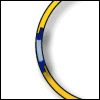Session Overview

|
This session will review how to make a recombinant cDNA library and how to use this library to find a specific gene. This session will outline the differences between a genomic and a cDNA library, and discuss how to use a cDNA library to clone a gene of interest. Learning Objectives
|
Session Activities
Lecture Video
Watch the lecture video excerpt
Check Yourself
Question 1
A recombinant vector in a yeast genomic library may contain more than one gene. This is not the case with the recombinant vectors in a yeast cDNA library because…
For a cDNA library, double stranded DNA is made from mRNA. In eukaryotes, each mRNA molecule represents only one gene.
Question 2
Unlike a genomic DNA library, particular care must be taken to ensure that the cDNA library represents every gene in the genome. Why is this the case?
A cDNA library is made from mRNA. A gene that is not actively transcribed in the cells used as a source of mRNA will not produce mRNA, so that gene will not be represented in the library.
Question 3
Many cDNA libraries are used as expression libraries. The vector chosen for use in an expression library must have additional DNA sequence that is not required in the vector chosen for use in a genomic DNA library. What is this sequence?
Session Activities
Help Session Video
Watch the short video of Robert Dorkin explaining transformation and protein expression.








